-
AAPL
213.43 (+0.29%)
-
BARC-LN
1205.7 (-1.46%)
-
NKE
94.05 (+0.39%)
-
CVX
152.67 (-1.00%)
-
CRM
230.27 (-2.34%)
-
INTC
30.5 (-0.87%)
-
DIS
100.16 (-0.67%)
-
DOW
55.79 (-0.82%)
Rishi Sunak’s immigration delusion
Few observers of politics can by now be in much doubt about the defective nature of Keir Starmer’s antennae when it comes to picking up the concerns of the British public. The number of U-turns the Labour leader has made once it has been explained to him what most voters actually think – the latest being over trans issues – is quite striking.
But we should keep in mind that Rishi Sunak’s antennae are not especially reliable either. He is neither an early period Thatcher with an innate understanding of the instincts of ‘our people’, nor an early period Blair with a natural popular touch.
Sunak’s relaxed position could be interpreted as a sign that more mass inward migration will follow if he is returned to power
The Prime Minister has just reminded us of this weakness in an interview with the always astute Paul Goodman of the ConservativeHome website. Naturally, Goodman questioned him about his pledge to ‘stop the boats’, yielding an admission from the PM that it might still be a work in progress by the time of the next general election.
That acknowledgment led to a flurry of tricky tabloid headlines. But it was not the issue on which Sunak left himself wide open to a political right hook. Though it took him a while, he clearly gets the extent of public fury about illegal immigration via the English Channel and is right to claim that he is doing far more to address it than any past premier has done.
What should concern every Tory supporter is the position that Sunak set out when Goodman went on to grill him on the related issue of legal immigration. This is particularly pertinent with regard to the OBR’s new forecast that it is going to average 245,000 a year net for the foreseeable future.
While the Prime Minister did suggest that such a high level of immigration was not necessarily a pre-condition for future economic growth, citing the potential for further welfare reform, he did not shut down the OBR prediction. Instead, he suggested that public concerns over legal immigration centred largely on the issue of ‘control’ rather than volume and that this had been addressed by Brexit. ‘Fundamentally, the decisions about who is coming here and what they are doing here…we are now in control of,’ he said.
Sunak then added: ‘The most important question, the thing that everyone talks to me about, is not that. It’s the boats.’
No doubt that is a comforting delusion to be under for the leader of a party which failed to fulfil a promise to reduce net immigration below 100,000 for ten years in a row before Boris Johnson dropped the pledge. Or for a leader whose party presided over immigration to the UK of an unprecedented one million people last year (half a million net). But it is a delusion, nonetheless.
The UK population has grown by more than nine million in the past quarter of a century, the great majority of that being due to high net immigration. The vast influx has put public services, housing, infrastructure, wages for working class jobs and community cohesion under great pressure. And for millions of socially conservative voters the proposed volume of future immigration is therefore at least as important as the theoretical ‘control’ UK governments now possess over it. A lot of opinion research actually points towards this concern being even greater among the working class former Labour voters who switched to the Tories in 2019 than it is among traditional Conservatives, though it is high among them too.
Tory prime ministers since David Cameron have failed to make good on promises to reduce immigration volumes. With this in mind, the average voter will surely interpret Sunak’s relaxed position on the issue as a sign that more mass inward migration will follow if he is returned to power at next year’s election. And they’d be right to do so.
That leaves a significant gap in the market for a party willing to commit to ending mass immigration and to switch to something far more socially sustainable. This is where Richard Tice and his Reform party may be about to make a significant intervention.
In recent weeks the Reform leader has been investigating the potential of a policy of ‘Net Zero Immigration’. This would involve moving to what Frank Field and Nick Soames referred to as ‘balanced migration’ when they launched a campaign for it in the 1990s. That is to say, the number of incomers would be pegged to the number of outgoers over a fixed period such as a four- or five-year parliamentary term. It would still allow for approximately 400,000 immigrants a year as that equates to the level at which annual emigration has recently settled. But it would also address concerns about immigration pushing up the UK population to unsustainable levels with all the deleterious effects that has involved.
As one source close to Reform puts it: ‘Nobody can say it is a North Korean option whereby the UK would simply pull up the drawbridge against foreigners. But equally it deploys the concept of sustainability that the Left have exploited when it comes to environmentalism. And it’s got the word zero in it.’
Tice is making a set piece speech at a Reform party gathering in Derby this weekend. If he nails his colours to the mast of Net Zero Immigration then Sunak is going to find himself badly gazumped in the contest for the affections of migration-sceptic voters.
Trans surgery and the problem with Channel 4’s Naked Education
When Channel 4’s new programme Naked Education – in which adults strip naked in front of children – was launched, it promised viewers it would be ‘all about body positivity’, and that it had a mission to ‘champion our differences and break down stereotypes’.
In the very first episode one of the participants, Martha, stated: ‘you have to accept yourself before you can love yourself’. Self-acceptance, from a therapeutic perspective, is extremely important.
Unfortunately, and perhaps unsurprisingly, the show, which is aimed at children, has already shown its inconsistent ideology. Entire segments are dedicated to individuals who seemingly did everything they could to change their bodies. The show then portrays them as the epitome of self-acceptance.
The focus of one episode was a conversation between Lucian and Finn, both of whom referred to themselves as ‘transmen’ (meaning they are biologically female).
Both Lucian and Finn discuss the ‘medical transition’ they had gone through or wanted to happen. They used the terms ‘gender affirming surgery’, ‘top surgery’, and ‘bottom surgery’. These terms are used euphemistically and do not get across the irreversible and potentially dangerous nature of such procedures.
The term ‘affirming’ is telling. Note how there is no explicit recognition of the fact that such surgery is fundamentally changing one’s body.
For a show that is designed to teach self-acceptance and body positivity, it was particularly striking when Lucian, who underwent a double mastectomy, said: ‘I was born in the wrong body… I never connected to my body… I can’t live in this body’.
Rather than the show’s ‘experts’ gently challenging this idea of being in the ‘wrong’ body and bringing the focus back to the importance of acceptance, we were instead told that such surgery is ‘amazing’. Lucian remarked thoughtfully: ‘I feel hot’.
Finn, who has had both double mastectomy and phalloplasty (the surgical creation of a penis) told viewers: ‘I’d always been a man and my body just hadn’t got the memo’. There is no evidence whatsoever to suggest that it is possible to be ‘born’ in the wrong body. Yet, this supposedly educational show left this statement unchallenged.
Again Finn’s double mastectomy was described in a deliberately euphemistic way as the ‘removal of breast tissue for a more male looking chest’. One could also describe it as: ‘the amputation of a completely healthy part of someone’s body’. But then again, this kind of statement probably wouldn’t appeal to Channel 4’s prime audience.
Finn went on to describe the phalloplasty, whimsically saying that ‘his penis’ is the same as any other penis. That is until we learn that ‘his penis’ is operated using an implanted erectile device, which must be pumped up using a saline solution stored in the abdomen and needs to be flushed out afterwards.
Finn went on to say: ‘I can still find my clitoris if I rummage under my testicles’. Not a sentence you usually expect to hear from a man.
At one stage, an opportunity presented itself to engage in deeper exploration of the discomfort and co-morbidities associated with ‘gender dysphoria’, a mental health condition. Finn described engaging in self-starvation when younger to avoid getting periods and stretches of self-abuse through drugs and alcohol.
Yet this was quickly sidestepped by the show, instead showing a photograph of Finn post-surgery, with a giant balloon reading ‘phallotastic’ on it.
At this stage, both Lucian and Finn stripped off to reveal their double mastectomy scars, both congratulating each other.
Finally, the show’s host, Anna Richardson, talked viewers through what can only be described as a shopping list of potential surgical options for ‘transitioning’, including hysterectomy. The closest we got to any caution or challenge is when Richardson said that each surgical option has ‘pros and cons’.
The above is striking for multiple reasons. It flies in the face of the entire notion of self-acceptance, instead suggesting to young viewers that if you don’t like a part of your body, you can simply change it.
This was particularly shocking given the other stories platformed by the show, including a young girl in tears as she recounted hating her breasts, and a woman who shared her battle with anorexia. Should they have simply changed their bodies?
The programme also showcased the stories of two brave women who had to undergo double mastectomies because of cancer. Listening to them only added to the feeling of sadness that young women are being encouraged to have completely healthy parts of their body removed.
More than anything, was the utter inconsistency. In an episode on cosmetic surgery, the show did its best to put children off such procedures. Dr Alex George stated despairingly: ‘what are we telling these children at age 14 if they want to go under the knife?’ The ‘experts’ spent time going through cosmetic procedures and listing out the significant risks associated with each one. Even a nose job, was described as ‘brutal’. Yet, in support of gender ideology, having one’s breasts or womb removed were portrayed as par for the course.
Equally, an entire episode focused on body dysmorphia, again from a stance of self-acceptance. Yet, there was no link whatsoever drawn between body dysmorphia and gender dysphoria.
Fleeting moments of the show felt more positive, particularly around bodily acceptance for those who have physical problems following medical trauma or underlying health conditions.
However, teaching young people that the answer to accepting oneself is to fundamentally change oneself through irreversible surgery is both utterly inconsistent and dangerously disingenuous.
Humza Yousaf’s incompetence will only help the SNP sink faster
Just don’t call him ‘Useless’. Humza Yousaf’s sister, Faiza, told STV last week of her shock and anger at hearing a hospital porter use the First Minister of Scotland’s ubiquitous soubriquet. Well, she’d better get used to it. Once an image is established in the public mind it’s hard to get rid of it. And it has to be said that his recent performance has been less than entirely useful.
It’s not entirely his fault, I accept that. Yousaf is burdened by the legacy of the nationalist duopoly, Nicola Sturgeon and Peter Murrell, which seems to have run the SNP with all the due diligence of a car boot sale. But having the leader of the party, and one of its longest-serving ministers, seemingly so remote that he didn’t know that the party’s auditors, Johnston Carmichael, had resigned six months ago, and that the party had not been able to find any other accountancy firm willing to validate their finances, is ignorance of a pretty high order. Just as he didn’t apparently know that the SNP had lost thirty thousand members in the last eighteen months. What, me worry?
£110,000 motorhome? Nope, Humza didn’t know anything about this luxurious vehicle that has been rotting quietly outside ex-Chief Executive, Peter Murrell’s, 92-year-old mother’s home for the last two years. He accepts that it was purchased by the SNP, reportedly for use as a battle bus for the 2021 parliamentary elections, but it was news to him until shortly before it was carted away by police. The explanation is that it was required by Covid regulations, but that doesn’t entirely make sense. If the party needed this vehicle as a kind of mobile lockdown HQ, why not do what every other party does and hire a bus for the duration of the campaign? That would have cost a fraction of the purchase price of the never-used glampervan, made by Niesmann+Bischoff whose company slogan just had to be: ‘Breaking all the Rules’.
Like so much else that is happening right now, the motorhome affair is as inexplicable as it is risible. But this is how you destroy a party leader’s credibility: by making him an object of ridicule. It happened to Boris Johnson over the £800 rolls of gold wallpaper used by designer Lulu Lytle to redecorate the Number 10 flat. Then by pointing to the Partygate saga and revelations about civil servants organising loans from businessmen. Individually, these matters were essentially trivial but together they created an image of an administration that didn’t know its derriere from its elbow.
Humza Yousaf is now emerging as a kind of tartan Mr Bean: a well-meaning incompetent lost in a sea of confusion. He always seems to be the last to know what’s going on and then invariably makes the situation worse. Like when he asked a meeting of war-weary Ukrainian refugee women ‘where are all the men?’ And now the National Executive of the SNP, supposedly the party’s ruling body, is now at war with itself with members briefing the press that it is ‘rotten to the core’.
Let’s not even mention the doomed legal action to overturn the Westminster veto on the Gender Recognition Reform (Scotland) Bill. Everyone and their dog knows that it isn’t going to succeed; is a waste of public money; is a futile defence of a flawed and deeply unpopular bill. But Humza is blundering on regardless with that hapless smile stapled to his face.
Next comes the deposit return scheme for bottles and cans – another of his commitments under the comic book coalition with the Scottish Green Party. Everyone knows it is dead. The scheme has been boycotted by thousands of small businesses and undermines the rather successful recycling schemes already run by Scottish local authorities. But Mr Bean is letting the hare-brained Circular Economy Minister, Lorna Slater, dig his government ever deeper into this landfill.
Then there is his stalled, billion pound Social Care Service, boycotted by unions and local authorities. Don’t mention the Cal Mac island ferries which seem to break down almost by the week while the hulks of the Glen Sannox and Hull 802 lie unfinished five years late and three times over budget.
Next week Humza Yousaf will be delivering his mission statement to Holyrood as the shell-shocked Scottish parliament returns from the wildest recess since dawn of devolution. We can only imagine what he has in store for Scotland. No doubt a commitment to abolish poverty, eradicate hospital waiting lists, get the trains to run on time and, er, help the police with their inquiries. But as his SNP rival, the former Finance Secretary, Kate Forbes, told him to his face three weeks ago: he’s already been there done that in a ministerial career consistent only in its failure.
Meanwhile the image of the Scottish National party continues to rust away like those unfinished ferries in the nationalised Ferguson Marine shipyard. The party is losing members so fast that Kate Forbes had to deliver an urgent and heart-felt appeal for SNP folk to keep the faith and stay in the party. Her subtext was that Useless isn’t going to be around very long, so just close your eyes and think of Scotland.
We can’t rely on the police to clean up mobile phone theft
A call from my younger son’s secondary school was not what I was expecting at 11.30 a.m., but as soon as I heard the secretary speak I knew what had happened to him.
He’d just got himself a pair of Apple AirPods and was keen to use them – why wouldn’t he be? As he stepped off the bus, with his new wireless earphones in place, he was followed up the road to the school by two boys.
A strategy which targets crime gangs is more likely to yield results than a drive to investigate every phone theft
Suddenly, from behind, they made their move, grabbing him in a headlock. It took only a few seconds but enough time for them to get what they wanted: the AirPods, of course – and his smartphone.
What happened to my son, who was 15 at the time, is par for the course among teenagers in London. Although the circumstances are not always as violent as that, I suspect most young people will have their phone nicked at one time or another. Figures obtained by the BBC show that in 2022 the Metropolitan Police received 91,000 reports of stolen phones from members of the public.
The number has barely budged over the past ten years and equates to one phone reported stolen every six minutes. And although the cases undoubtedly include false claims, where people seek a crime reference number for phones that have been lost, broken or flushed down the toilet, the true figure is probably higher. According to separate data from the Office for National Statistics (ONS), only around 63 per cent of thefts are reported to and recorded by police in England and Wales.
Phone theft is not a new phenomenon. In 1995, an information leaflet circulated to MPs by the Parliamentary Office of Science and Technology said mobiles were at the ‘centre of a rapidly growing crime wave’ with around 16,000 devices stolen across the UK every month. The cost of mobile phone crime was estimated at the time to be around £200 million each year.
Even in the mid-90s, with only 3 million phones in circulation in the country compared to 72 million mobile connections now, the authorities were having difficulty containing the problem. ‘The rapid growth in mobile phone crime initially took the industry by surprise and ever since it has been struggling to protect itself, with mixed results,’ the document says. ‘As soon as one weak point is dealt with, others open up to the extent that some in the industry see themselves in a continuous “guerrilla war” with the criminal community.’
Back then, the telecommunications industry was seen as key to tackling mobile phone crime through tighter regulations around the sale and use of handsets and improved security features. The police, in that paper at least, were not seen as the main answer to the problem. The sheer volume of cases, even 30 years ago, meant that alternatives to arrest and prosecution were required.
Changing patterns of car crime demonstrate that it is possible to bear down on a particular type of offending by designing it out rather than relying on the criminal justice route. In 1995, almost 500,000 vehicles were stolen, according to the ONS Crime Survey of England and Wales (including cases not reported to police). Last year, that had dropped to 72,000. The number of thefts from vehicles, such as car stereos, also plummeted from 2.5 million to an estimated 519,000. Electronic immobilisers, deadlocking systems and alarms are the main enhancements that are widely credited to have kept criminals at bay.
Mobile phone security has improved as well. Features that allow users to trace their handset, lock applications and wipe data remotely have made the thief’s job harder. As a result of these measures, they may not be able to re-set the device and sell it on, or access the personal information which enables them to spend money.
But there is still, clearly, a lucrative global market for stolen phones – particularly for spare parts. One man who had his £1,000 iPhone 14 Pro stolen in London reportedly tracked it down to a street in Shenzhen, China, 6,000 miles away, where he suspected it was about to be cannibalised. With a bit of expertise, elements from different devices can be assembled in such a way that a phone looks as though it’s a new or nearly new model. It suggests that although most phone thefts are opportunistic, in some cases organised criminal networks are involved, shipping handsets overseas where they can be broken down, reconstituted and sold on.
A strategy which targets crime gangs, therefore, is more likely to yield results than a drive to investigate every phone theft. In London, certainly, the latter just isn’t possible. Unless violence is used, or there’s a clear pattern of offending, for example by using mopeds to target people, the police response will be minimal. The Met’s Basic Command Units, where the officers responsible for dealing with such cases are based, were said to be ‘creaking at the seams’ by Baroness Casey in her recent review of the force. Mobile phone theft is simply not a priority, with only 2 per cent of phones recovered.
My son never got his phone back either. We managed to trace someone who had used it to order items online and supplied that information to the police. The ‘safer schools’ officer who was handling the case was helpful and diligent; he pursued it for a while…before being diverted onto more pressing matters.
It’s sad to say, but we can’t rely on the police to solve this problem – it’s down to us. Keep your phone secure and take extra care when you put your AirPods in.
Unions split over NHS pay
There’s disappointment in Downing Street this evening after nurses at the Royal College of Nursing voted to reject the government’s offer of a 5 per cent pay rise for 2023-24, along with a one-off lump sum payment. It was a close result, with 54 per cent rejecting the offer and 46 per cent voting to accept it. Following the result, the union promised fresh strikes as they attempt to put pressure on the government to come up with a more generous offer. The first of these is a 48-hour walkout over the May Bank Holiday weekend. In response, a government spokesperson branded the move ‘hugely disappointing’ and blasted the escalation of ‘strike action with no derogations, based on a vote from the minority of the nursing workforce’.
However, in better news for the government, members of Unison, which is the biggest union for overall health workers, voted to accept the offer – with three quarters voting to accept it. Speaking on Radio 4 this evening, Unison’s Sara Gorton said:
What’s really clear is that three quarters of unison members, you know, over 112,000 people have voted to tell me that they want to accept the pay offer that was on the table as an alternative to taking more strike action.
Both unions had recommended its members accept the offer. So, what happens now? There are still two unions holding ballots so the level of resistance to the current offer will become clearer in a few weeks’ time. In theory, the pay deal could pass without every union backing it but that could still mean industrial action from the unions against it.
For Sunak, today’s results are difficult. First, hopes for an agreement on pay have played into the idea that the Prime Minister is adept at solving tricky problems. A failure to end the strikes suggests the opposite. There is plenty more industrial action coming up the track including civil servants and teachers.
What’s more even if public opinion turns against the striking workers, the effect of ongoing strikes in the NHS will be painful both for patients and the Prime Minister’s political fortunes. One of Sunak’s five priorities is to reduce NHS waiting lists. As NHS confederation boss Matthew Taylor put it this morning, ongoing strikes will make hitting that target ‘very very difficult, perhaps almost impossible’.
The US intelligence leak and the hypocrisy of the spy world
So what did everyone learn from the massive trove of more than a hundred top secret US documents a 21-year-old Air National Guardsman apparently put on a gaming server to wow some fellow God-fearing gun enthusiasts? Both little and a lot.
Despite some clumsy cut-and-paste editing of casualty figures, as well as some carefully-worded claims that, as a British defence official put it, ‘a significant proportion of the content of these reports is untrue, manipulated, or both,’ the Americans are shamefacedly admitting that these are genuine documents. There will no doubt continue to be suspicions in some quarters that there is some baroque plot at work, whether a Russian long con or a US attempt to spread disinformation. But nevertheless this is one of those cases where the simplest explanation is the most likely.
Everyone spies on everyone else; everyone knows it; everyone pretends otherwise
The focus has unsurprisingly been on the materials relating to the Ukrainian war. There did not seem to be anything there that would have radically changed the Russian understanding of the situation, but the role of intelligence is often to provide shape and detail to what was already assumed.
There certainly is a lot of granular detail for the Russian General Staff’s analysts to get their teeth into. Moscow knew, for example, that the Ukrainians were using a lot of their finite stock of S-300 air defence missiles, but now they have specific numbers, from which they can divine just how long before they are exhausted.
Perhaps more important is the way this will give the Russians a better sense of just how much the Americans know about their own plans, forces, dispositions and movements. From this, they may be able to assess ways of spoofing electronic intelligence gathering and where any US human assets may be found. Moscow is often careless in precautionary security – as Bellingcat discovered when it bought databases on the black market which helped identify Russian military intelligence officers – but can be ruthless and methodical in reacting to leaks and clues.
However, much attention has also rightly been directed towards what the documents reveal about US spying elsewhere – and what it has uncovered. That South Korea was secretly trying to bypass its own usual practices and find ways of selling weapons to Kyiv was one thing. That Serbia, one of Moscow’s last friends in Europe and a regular beneficiary of Russian hand-me-down aircraft and diplomatic cover, was doing the same – potentially deeply embarrassing.
Kyiv is unlikely to be pleased about the suggestion that the Russian A-50 airborne early warning aircraft attacked at a Belarusian airbase was the target not of local dissidents but a maverick Ukrainian intelligence operation. That said, there is also a certain satisfaction that its reluctance to share detailed information on plans and even casualties on the grounds of security appears justified. Yet this goes hand in hand with a certain performative outrage behind the scenes that the Americans were spying on their Ukrainian allies at all.
But what did anyone expect? Everyone spies on everyone else; everyone knows it; everyone pretends otherwise. Find yourself competing against a French arms company and it’s an open secret that you’ll have the DGSE, its answer to the Secret Intelligence Service (MI6), after your commercial secrets. The Anglosphere ‘Five Eyes’ nations – the UK, USA, Canada, Australia and New Zealand – promise not to spy directly on each other, but in the words of one former spook, ‘that doesn’t mean we don’t pick up bits and pieces in third countries’.
Beyond those countries where there are real grounds for embarrassment and political damage, there is a great deal of humbug. Along with that, the sense of mingled horror and satisfaction at seeing the mighty Americans humbled is tempered with a keen appreciation on the part of the intelligence professionals that, but for the grace of God, there go them all.
After all, everyone and everything leaks, whether because someone incautiously takes classified materials home and leaves them on the train, or talks too freely over drinks in the bar. This is a serious embarrassment for the Americans, not just for its scale but its source.
Perhaps one of the greatest ironies is that it was neither a committed whistle-blower nor a deep-cover intelligence asset behind this massive intelligence breach apparently, but a moderately-clueless ‘Cyber Transport Systems Journeyman’ trying to impress his bros on a Discord gaming chat site. Move over, George Smiley.
When will Steve Barclay compromise with striking doctors and nurses?
Nurses in England have today rejected the government’s pay deal and have announced a fresh round of strike action. The next strikes will take place over 48 hours from 8.p.m on 30 April to 8.p.m. on 2 May, with no emergency cover. The Royal College of Nursing ballot showed that 61 per cent of eligible voters turned out. The vote was close: 54 per cent voted to reject the government’s offer – of a pay rise between 4.5 and 5 per cent – while 46 per cent voted to accept the deal.
The staffing crisis only exacerbates the pressures felt by junior doctors. Many tell me how consultants and hospital managers alike have resorted to intimidation in attempts to force juniors to cover rota gaps.
The timing is a killer blow for the government: it was expected that if the nurses were to accept this pay offer, it would set the tone for successful negotiations with other striking sectors. But this is not to be, and now there is speculation that future strikes could see doctors and nurses walk out together. Currently the government is refusing to compromise on pay disputes with junior doctors in England until they call off the strikes and decrease their starting request of a 35 per cent pay rise. Striking doctors have just over 12 hours left of their four-day strike, which is the longest the profession has undertaken in the history of the NHS. The BMA is asking for pay restoration to account for real terms pay cuts and inflation as the exodus of junior doctors from the UK is on the rise. Talks in March broke down when BMA representatives and health secretary Steve Barclay were unable to find common ground. Junior doctors say they will negotiate — but the government remains stubborn.
Today, the BMA Junior Doctor Committee wrote to Barclay saying that they would be open to have negotiations facilitated by Acas, a third-party organisation which aims to improve industrial relations. ‘We are available to meet immediately,’ the letter read. ‘We do not have any preconditions to negotiations with you. Given the barriers you have put in place to negotiations so far, we have confirmed to Acas our willingness to engage in a process facilitated by them.’
On Tuesday, a statement from Downing Street insisted that no talks would be held with the doctors’ union, the BMA, unless junior doctors ‘abandoned their starting position of a 35 per cent rise and called off the strikes’. It seems, however, that Mr Barclay doesn’t quite understand the meaning of negotiation. While almost all junior doctors are aware that they will not receive a 35 per cent pay rise, the union has said that they were after a ‘credible offer’ and that the figure is their preferred starting point from which compromises can then take place.
A recent Ipsos poll shows that both nurses and junior doctors have the public on their side: the poll found that 60 per cent of the public are in favour of nurses taking industrial action, while 54 per cent are in favour of junior doctor strike action. As I wrote recently, though it is difficult to predict if this support will last, having the public on side is a significant win for both the nursing and doctors’ unions.
The combination of long hours, physically demanding work and having to – literally – make life-or-death decisions against the backdrop of a bullying work culture has resulted in a growing frustration amongst junior doctors about how they are valued in the workplace. In England, junior doctors are paid a base salary, and may receive additional pay on top of this depending on how many night or weekend hours (antisocial hours) they work. For those starting out, the base pay can start at around £29,000 which, as the BMA has calculated, works out at approximately £14 per hour. Though campaign messaging that compares the pay of junior doctors to that of private sector workers in unskilled jobs has been controversial, their frustration is clear: medicine is a difficult, exhausting vocation and if doctors don’t feel valued for their work, both mentally and physically, then they will go wherever will treat them better.
And, unfortunately, that is what’s happening. The exodus of doctors from the NHS to countries like Australia has resulted in the worst workforce crisis the health service has seen. As I have written before, the UK provided Australia with 13 per cent of its GPs and 22 per cent of its specialists in 2011. There was a 17 per cent increase in the number of British doctors working in Australia and New Zealand between 2014 and 2016. The NHS is currently facing over 130,000 vacancies across the health service.
The staffing crisis only exacerbates the pressures felt by junior doctors. Many, from a number of different hospitals across the country, have told me how consultants and hospital managers alike have resorted to intimidation tactics in attempts to force their juniors to cover rota gaps. A significant proportion have no say in when they can take time off work, with some relaying horror stories about difficulties planning their own weddings – or missing funerals.
While the chairs of the BMA’s Junior Doctors Committee have been described as assuming a ‘political militant stance’, their strategy appears straightforward. The workforce crisis is crippling the NHS. To pull in more doctors, the working conditions need to become more attractive. To make working conditions more attractive, doctors need to feel better valued – and to be better paid. Paying doctors better will keep current medics in the UK, while hopefully encouraging more people to study medicine. Focusing solely on pay means that the government can’t dangle unquantifiable distractions in front of striking workers that may never come to fruition.
There continues to be furious debate about whether public sector pay rises drive inflation. Rishi Sunak is no stranger to this argument and Andrew Bailey, governor of the Bank of England, urged workers to stop asking for more money last year on this very point. Economists are split, and some have pointed out that there is ‘no evidence’ that public sector wage increases cause inflation to rise.
The vast majority of people agree that doctors deserve to be paid, and treated, better. Equally, a rise of 35 per cent is widely agreed, even by a number of striking doctors themselves, to be wholly unrealistic. But while the leadership of current BMA reps Rob Laurenson and Vivek Trivedi has been criticised, starting from a high bargaining position does make logical sense. While some have said that a rise of 20 per cent is closer to what they’d be happy with, some have gone even lower. ‘I’d hope for 15 per cent,’ one told me.
This may be a more palatable solution for the government, but it won’t be reached if Barclay refuses to engage. As Fraser Nelson said on Coffee House Shots, 'There are so many more intelligent ways of [the government] dealing with this than simply stonewalling and saying "no".' NHS bosses have today said that the strikes are making it 'almost impossible' to slash hospital wait lists. For the sake of the country, it is imperative that there is movement on the current position – from both sides.
A 100-1 shot for the Grand National
My late father, who was the kindest man I have ever encountered, introduced me to horse racing when I was a small boy. Although he died all of 33 years ago, I still remember his advice to me when betting on the world’s most famous horse race: ‘The best form for the Grand National is… the Grand National.’
He was convinced that very few horses were capable of both jumping the unique Aintree brush fences and truly staying the marathon trip, which is now 4 miles 2 and a half furlongs. So he concentrated his bets on horses that had done well in the race the year before.
A few trainers seem to share my father’s thinking because the first three home a year ago all return once again tomorrow (5.15 p.m. race), along with plenty of other horses who fared with varying degrees of success, or otherwise, 12 months ago.
I put up my first bets for this year’s race in a column just before Christmas, concentrating on two horses I fancied strongly and that I knew were being aimed at the race. I suggested each way bets at 20-1 on Corach Rambler, who is now favourite for the race at around 8-1, and 33-1 on Lifetime Ambition, who is a bit of a forgotten horse for the race but who still makes plenty of appeal at odds of up to 28-1.
Corach Rambler managed to win the Ultima Handicap Chase at Cheltenham last month, for the second successive year, and is a fine jumper and strong stayer. The minuses are he is untried over both the Aintree fences and a marathon trip but he is undoubtedly the best handicapped horse in the race: 10lb ‘well in’ on his old mark that he can run off tomorrow before his new rating kicks in. However, if you have missed the price, he makes little appeal off his current skinny odds.
Lifetime Ambition is well named because his veteran Irish trainer Jessica Harrington is desperate to win the Aintree National for the first time. Victory for this lovely staying chaser and sound jumper would also give the race a fabulous storyline as the widely-admired Harrington is currently undergoing chemotherapy for breast cancer.
More than two months ago, I added Any Second Now to my big-race portfolio. Within days, his trainer, Ted Walsh, was left fuming when the handicapper gave his horse top weight. However, Any Second Now is a real National specialist having been an unlucky third two years ago and a close second a year ago. Now 11 years old, this gelding has a huge each-way chance even with top weight and odds of up to 16-1, many places, are still appealing.
As always, there are plenty of other runners with chances, perhaps led by Longhouse Poet, who was a well-beaten sixth last year when he ran too keenly. If he can be ridden with more restraint this time around, he will have a major chance for his astute Irish handler Martin Brassil.
If the ground had been really soft or heavy, I would have been tempted to suggest an each way bet on Hill Sixteen too but he is unlikely to win on the likely ‘good to soft’ ground. But, at huge odds, I am instead going to suggest a sporting bet on FRANCKY DU BERLAIS. His trainer, Peter Bowen, loves running horses over the Aintree fences and with great success too, having won the Topham Chase no less than five times.
Francky Du Berlais has successfully negotiated the Aintree fences three times, including when fourth behind stablemate Mac Tottie in the Randox Topham Handicap Chase 12 months ago. There is a huge question mark, however, over whether this horse will stay the National trip and he may not do. But at huge odds I am happy to take that risk.
Back him each way at 100-1, six places, with bet365, Paddy Power, Betfair and others (though others may prefer 80-1 seven places with Sky Bet). The 100-1 odds equal 20-1 for a place on a talented horse, sound jumper and from a stable with plenty of success over these fences. That’s too big in my book.
Don’t be put off by the ‘R’ by Francky Du Berlais’s name for his last run. He refused at the last fence in the Glenfarclas Cross Country Chase at Cheltenham last month, but that was because a loose horse ran across him. He was third at the time, if a distant one, and had run a sound race at level weights against two classy animals.
I will be cheering on Gesskille this afternoon in the Topham Handicap Chase (4.05 p.m.), having put him up at 16-1 three weeks ago. He is now joint favourite at around half those odds.
In the Aintree 4.15 p.m. race tomorrow, I was tempted to put up both Nassalam, who race poorly at the Cheltenham Festival after making an early mistake, and Coconut Splash, who has also not met my expectations this season. But I will, in fact, pass on both this time around with the odds not big enough to suggest any bets.
Instead, I am going to put up a bet on another favourite horse of mine: ANNSAM for a big spring handicap chase. Evan Williams’s talented stayer has won two of his last three races and is now up to a lofty mark of 149.
However, now that he has learnt to settle he can defy his new rating with a big run in the bet365 Gold Cup Handicap Chase at Sandown on 29 April. He should thrive on this track as he is much better going right-handed because of his tendency to jump to the right. I fancied him at a big price for the Coral Gold Cup at Newbury in November but on that left-handed track he faded to finish sixth.
There is talk of a possibly alternative target for Annsam at the Sandown meeting but I hope connections will be brave and target this £90,000 pot for the winner of the bet365 Gold Cup. Back him each way at 16-1 with either Ladbrokes or Unibet, both paying four places.
Anyway, enjoy the excitement of the world’s biggest race tomorrow, win or lose. The main thing is that all 40 horses and their jockeys return home safe and sound.
2022-3 jumps season running total + 42.5 points on all tips.
Pending bets:
1 point each way Gesskille at 16-1 in the Topham Chase, paying 1/4 odds, four places.
1 point each way Corach Rambler at 20-1 in the Aintree Grand National, paying 1/4 odds, four places.
1 point each way Lifetime Ambition at 33-1in the Aintree Grand National, paying 1/5 odds, five places.
1 point each way Any Second Now at 20-1in the Aintree Grand National, paying 1/5 odds, five places.
1 point each way Francky Du Berlais at 100-1 in the Aintree Grand National, paying 1/5 odds, six places.
1 point each way Annsam at 16-1 in the bet365 Gold Cup, paying 1/4 odds, four places.
Settled bets:
1 point each way Hill Sixteen in the Becher Chase at 11-1, paying 1/5 odds, six places. Unplaced (7th). – 2 points.
2 points win Annsam at 8-1 for the Howden Silver Cup. Cancelled meeting. Stake returned.
1 point each way Eldorado Allen at 20-1 in the King George VI Chase, paying 1/5 odds, 3 places. Unplaced (4th). – 2 points.
1 point each way The Big Breakaway in 20-1 for the Welsh Grand National at 20-1, paying 1/5 odds, five places. 2nd. + 3 points.
1 point each way The Big Dog at 12-1 in the Welsh Grand National, paying 1/4 odds, four places. 3rd. + 2 points.
1 point each way Grumpy Charley at 12-1 in the Newbury 2.25 p.m. paying 1/5 odds, five places. 1st + 16.4 points.
2 points win Midnight River at 5-1 for the Cheltenham 1.55 p.m., with Skybet. 1st. + 10 points.
1 point each way Coconut Splash at 12-1 in the Cheltenham 1.55 p.m., with William Hill, paying 1/5 odds, six places. Unplaced (P). – 2 points.
1 point each way Sir Ivan at 20-1 in the Sandown 3 p.m., paying 1/5 odds, 5 places. Unplaced. – 2 points.
1 point each way Lord du Mesnil at 8-1 in the Warwick 3 p.m. race, paying 1/5 odds, 5 places. Unplaced. – 2 points.
1 point each way Dubrovnik Harry at 8-1 in the Kempton 2.40 p.m. race, paying 1/5 odds, 7 places. Unplaced. – 2 points.
1 point each way Mister Coffey at 15/2 for the Doncaster 3.15 p.m., 1/5 odds, five places. Non Runner. Stake returned.
1 point each way Back On The Lash at 7/1 for the Cheltenham 12.40 p.m., 1/5 odds, five places. 1st. + 8.4 points
1 point each way Empire Steel at 12-1 in the Sandown 3.30 p.m., paying 1/5 odds, 5 places. Unplaced. – 2 points.
1 point each Small Present at 25-1 for the Grand National Trial (Haydock 2.40pm) paying 1/4 odds, four places. Unplaced – 2 points.
1 point each way Homme Public at 9-1 for Ascot 3 p.m., paying 1/5 odds, four places. Unplaced. – 2 points.
1 point each way Party Business at 20-1 NRNB for the Pertemps Network Hurdle Final, paying 1/5 odds, five places. Non Runner. Stake returned.
1 point each way Benson at 16-1 in the Morebattle Hurdle, paying 1/5 odds, five places. 1st. + 19.2 points.
1 point each way Monviel at 17/2 for the Imperial Cup, paying 1/5 odds, six places. 5th. + 0.5 points.
1 point each way Saint Segal at 20-1 NRNB for the Grand Annual, paying 1/5 odds, five places. Non Runner. Stake Returned.
1 point each way Elixir de Nutz at 20-1 NRNB for the Plate Handicap Chase, paying 1/5 odds, five places. Non Runner. Stake Returned.
1 point each way Doctor Bravo at 22-1 for the Sky Bet Supreme Novices’ Hurdle, paying 1/5 odds, four places. Unplaced. – 2 points.
1 point each way Nassalam at 20-1 NRNB for the Ultima Handicap Chases, paying 1/5th odds, five places. Unplaced. – 2 points.
1 point each way I Like To Move It at 20-1 for the Unibet Champion Hurdle, 1/5 odds, three places. Unplaced. – 2 points.
1 point each way Metamorpheus at 16-1 NRNB for the Boodles Juveniles Hurdle, paying 1/5 odds, 5 places. 6th. – 2 points.
1 point each way Mister Coffey at 25-1 for the National Hunt Chase, paying 1/5th odds, three places. 3rd. + 4 points.
1 point each way Camprond at 20-1 NRNB for the Coral Cup, paying 1/5 odds, five places. 3rd. + 3 points.
1 point each way Elixir de Nutz at 14-1 for the Grand Annual Chase, paying 1/5 odds, five places. Unplaced. – 2 points.
1 point each way French Dynamite at 14-1 NRNB for the Ryanair Chase, paying 1/5 odds, three places. Unplaced. – 2 points.
1 point each way Dashel Drasher at 28-1 for the Stayers’ Hurdle, paying 1/5 odds, four places. 3rd. + 4.6 points.
1 point each way Gin Coco at 14-1 NRNB for the County Hurdle, paying 1/5 odds, five places. Unplaced. – 2 points.
1 point each way Hewick at 20-1 NRNB for the Cheltenham Gold Cup, paying 1/5 odds, three places. Unplaced. – 2 points.
1 point each way Royal Pagaille at 50-1 NRNB for the Cheltenham Gold Cup, paying 1/5 odds, three places. Unplaced. – 2 points.
1 point each way Magic Daze at 11-1 for the Mares Chase, paying 1/5 odds, three place. Refused to race. – 2 points.
1 point each way Might I at 10-1 NRNB for the Martin Pipe Hurdle, paying 1/5odds, five places. 4th. + 1 point.
1 point each way Iroko at 9-1 for the Martin Pipe Hurdle, paying 1/5 odds, five places. 1st. + 10.8 points.
1 point each way The Galloping Bear at 14-1 for the Midlands Grand National, paying 1/4 odds, four places. P. – 2 points.
1 point each way Notachance at 33-1 for the Midlands Grand National, paying 1/5 odds, five places. 3rd. +5.6 points.
1 point each way Secret Reprieve at 10-1 for the Midlands Grand National, paying 1/5 odds, five places. P. – 2 points.
1 point each way Dans Le Vent at 33-1 for the Uttoxeter 3.35pm, 1/5 odds, three places. U. – 2 points.
1 point each way Panda Boy at 16-1 in the Irish Grand National, 1/4 odds, four places. 5th. – 2 points.
My gambling record for the seven years: I have made a profit in 13 of the past 14 seasons to recommended bets. To a one-point level stake over this period, the profit of has been just over 469 points. All bets are either one-point each way or two-points win (a ‘point’ is your chosen regular stake).
Is King Charles bringing Andrew back into the fold?
I am beginning to wonder if there are, in fact, two incarnations of King Charles that co-exist simultaneously. The first is a remarkably generous-spirited and forgiving man, who responds to insults and slights with Christ-like forbearance and shows nothing but a genuine love for his country and his people. And the second is a more flawed and capricious human being, who displays his temper both publicly and in acts of revenge against members of his family who have displeased him.
If Charles really has managed to neutralise the two most troublesome and publicity-hungry members of the Firm, it’s a remarkable achievement
These personae may appear to be contradictory, but when it comes to the coronation, it is the first side of him that has been on display. Now that it has (finally, belatedly) been confirmed that Prince Harry will indeed be attending the ceremony in three weeks’ time, the potential for embarrassment and difficulty has been considerably reduced, if not removed entirely; this is, after all, a Prince who recently wrote an excoriating memoir that was less than flattering about both his father and his stepmother. And so it has been revealed that Charles is in what has been described as ‘a forgiving mood’ towards the members of his family who he considers to have transgressed.
According to the typically well-briefed Camilla Tominey in the Daily Telegraph, a ‘friend’ of the Royal Family has revealed that ‘there’s a warmth around the place and a proper rallying around the King, who in turn is showing some serious EQ (emotional intelligence) by ensuring the family is given the opportunity to pull together’. In practice, this means that the Duke of York, who a matter of months ago had been sent into reputational Siberia and had been cast out of Buckingham Palace, has spent both Christmas and Easter with the King, and in exchange for both public and private loyalty (no anonymous newspaper briefings here), has been welcomed back into the fold. If Charles really has managed to neutralise the two most troublesome and publicity-hungry members of the Firm, it’s a remarkable achievement.
So are rumours of Royal dissent simply exaggerated? According to the ‘friend’ quoted in the Daily Telegraph, yes. ‘The family aren’t briefing against one another. If it’s palace officials going off-piste and providing hostile press briefings on who wears what and when, who lives here or there, then they should think on. If it damages an individual royal, it damages the institution and it doesn’t reflect the private unity of the family.’ In other words, blame the courtiers, who are disposable and dispensable, not the royals, who are blameless and just want to be liked.
It’s not too hard to see why this is the dominant view at the moment. If the coronation is to be both an international and personal success for the King, it is vital that the Royal Family present a united front; I have visions of an awkward embrace being stage-managed between William and Harry for public consumption. Yet as the institution’s woes and battles over the past few years have proved, there is often a gap between noble intention and the rather more eventful execution of their aims. Let us hope, for everyone’s sake, that the incarnation of the monarch that processes into Westminster Abbey on 6 May is the forgiving, Christian kind – and not the more vindictive, petty King, who may yet find that his powers of patience and tolerance can still be exhausted by his troublesome family.
What’s the truth about long Covid?
How big a deal is long Covid and can it be treated? Opinions range from it being a serious impediment to the health of millions of those who suffered from Covid-19 to a figment in the imagination of the workshy. A study by the University of Oxford of a drug developed by US Pharmaceutical company Axcella Therapeutics may just help to shed some light. The drug, AXA1125, is designed to boost the performance of mitochondria, which generate energy for our cells and control the amount of inflammation in the body. It is believed that long Covid causes fatigue – among other symptoms – by inhibiting the mitochondria.
While a drug to treat fatigue would be welcome, there is also a potential use for a magnetic resonance test to measure mitochondrial function
A randomised, double-blind trial conducted by Oxford University, and reported in the journal eClinical Medicine, found that patients given the drug reported lower subsequent levels of fatigue than a control group which was given a placebo. All those who took part had been reporting feeling fatigued for 18 months previously. Given that around 10 per cent of people infected with Covid have reported suffering some kind of long-term symptoms, there is an obvious interest in a treatment. However, the Oxford study was tiny, involving just 41 participants and looked solely at fatigue rather than breathlessness and heart function which are also often reported as symptoms of long Covid. Therefore, it has a limited amount to say on the prospects of AXA1125 being an effective treatment.
Might such a drug succeed in reducing the very large number of people who seem to have disappeared from the workplace since before the pandemic? The IFS recently reported a shocking doubling in the number of people being put onto long-term disability benefits in the year to July 2022. There has also been a sharp rise in the sickness rate – the percentage of the workforce off sick at any one time – to 2.2 per cent in 2021. This was the highest rate since 2010 and partly reversed a downward trend which has lasted three decades. Given that the largest contributor to the increase in disability claims was mental and behavioural conditions – which accounted for 70 per cent of the increase among the under-25s – it seems unlikely that a drug which tackles fatigue will have much effect on these numbers.
But the Oxford study does reveal something interesting. Researchers used magnetic resonance spectroscopy to scan the patients’ calf muscles as they bent and straightened their legs, to test for a physical basis for their reported symptoms. While a drug to treat fatigue would be welcome, there is also a potential use for a magnetic resonance test to measure mitochondrial function. Might it one day be able to be used to detect whether a patient who is claiming symptoms of long Covid, ME or other conditions really is physically ill or whether they are inventing their symptoms?
Biden can no longer afford to indulge Irish nationalism
For the British government, the Biden visit to Belfast posed one major exam question: would the pageantry of a pan-nationalist juggernaut rolling into town, led by the most tribally Irish-American President of all time, make it appreciably harder for the DUP to accept the Windsor Framework and so to re-establish the Stormont Executive as the cornerstone of the Good Friday Agreement? For as it stands, Rishi Sunak’s mission to stabilise the Union in all its constituent parts is not yet complete.
Put simply, the UK is an infinitely more important partner for the US in maintaining world stability than the still neutral Republic of Ireland
Every moment of the US President’s brief time in the province had to be evaluated according to that exacting yardstick. Tin-eared locational and linguistic symbolism risked raising the hackles of unionist ‘Middle Ulster’, otherwise known as the proverbial ‘Prod in the garden centre’.
The visit also had the risk of fuelling communal excitability at a time when the dissident republican threat is growing again and with another potentially divisive election next month. The local media’s rather self-regarding yearning for poetry infused soliloquy (their own as much as the President’s), was a secondary concern. Not everyone needs to live through the excitement of 1998 all over again.
The historical memory at the top of the British government was thus strong enough to prevent a repetition of the imbalance of the last of Bill Clinton’s visits to Northern Ireland as President in 2000.
Clinton’s valedictory tour contrasted markedly with the political discipline he showed on his first two trips in 1995 and 1998 when he accorded both unionist and nationalist communities ‘parity of esteem’ in both his public pronouncements and in the aesthetics of the sites he visited.
In 2000, the British government under Tony Blair did not push back strongly enough at the White House when the final visit to both the Republic and Northern Ireland was being organised — because they felt they could not deny Clinton his lap of honour as his days in the White House came to a close.
Clinton badly wanted the IRA decommissioning weapons as his crowning achievement in the affairs of Ireland and to that end felt he had to nudge Sinn Fein gently (so gently, as it turned out, that they delivered nothing to him in the end: the act of decommissioning was finally done under the Presidency of George W Bush, who had done almost nothing for Irish nationalism but led an America that had been shaken out of lazy complacency about the reality of terrorism).
The Biden visit to Northern Ireland this week was far more at the 1995 and 1998 end of the scale. The main lesson of the visit is that the weight of the British state — still the key player in the Ulster crisis — counted for something both domestically and on the international stage. And if the institutions get back up and running again in the next few months, those who quietly steered the Presidential visit towards respect for the sensitivities of Northern Ireland will have earned their place in the history of Anglo-American diplomatic relations.
Despite the ‘noises off’ from Capitol Hill calling for a more ethnocentric approach, both the White House and State department professionals acted in the spirit of Senator George Mitchell, the chairman of the all-party talks, rather than Rita O’Hare, Sinn Fein’s former Washington DC representative.
In contrast to former speaker of the House of Representatives Nancy Pelosi and the voluble Congressman Richie Neal of Massachusetts, the foreign policy establishment knows that in international law the US is not a guarantor of the Good Friday Agreement. This awareness was further exemplified by Presidential envoy to Northern Ireland, Joe Kennedy III, sticking to his economic brief and not straying into politics in the run up to Biden’s visit.
The day’s proceedings reminded that Ulster has an ability to generate its own controversies that cut across the finest of diplomatic niceties. First, the Presidential visit was preceded by republican rather than loyalist low-gradery on the streets of Northern Ireland in the form of rioting in Londonderry by pro-dissident elements. For once, given its habit for self-defeating rage, Unionism was therefore not placed on the moral defensive.
Second, the claim by former First Minister Arlene Foster on her GB News show that Biden was anti-British led to the Biden team denying that the Commander-in-Chief was Anglophobic. Indeed, his English forebears were montaged to even up the ethnic score.
At one level, it was all fairly meaningless; but the mere fact that the Biden administration had to genuflect in this way was significant. Again, this was recognition by the US administration that it takes two (communities) to tango.
The choice of venue for Biden’s big set piece speech, at the new University of Ulster campus, was in the impeccably neutral Belfast city centre (as so often, another Northern Ireland grand projet paid for by the British taxpayer: the reality of US investment has always lagged behind the extravagant hopes and even promises).
Significantly, Sunak did not join Biden for this speech — just as Major and Blair largely left Clinton to his own devices. It later transpired, only because he was spotted by a member of the public, that Sunak had made the journey to pay a very discreet visit to the officer shot in Omagh, Co Tyrone, recently by republican dissidents whilst coaching a youth football team.
It was of a piece with Sunak’s message last Saturday, quoted on the front of the News Letter, the main unionist daily in the province, tipping his hat to the role of the security forces in bringing about the peace process. All this points to a long overdue willingness of the government to challenge the predominance of Irish Republican narratives on both sides of the border, which hold that the campaign of ‘armed struggle’ during the Troubles was unavoidable. Again, the struggle for the past is critical to the communal mood — and thus for the willingness of the DUP to agree to the restoration of Stormont.
The only wild card now might be Biden’s verbal indiscipline on the southern leg of his visit to the island of Ireland: senior figures recall that even Tony Blair’s team was utterly unsighted on the optics of Clinton’s final visit to the Republic in 2000.
But at least Biden’s semi-comedic conflation of the All Blacks with the Black and Tans concerned events sufficiently in the past as not to be offensive. The chances of a conscious atrocity, after the fashion of Charles de Gaulle’s infamous ‘Vive Le Quebec Libre’ speech at Montreal City Hall in 1967 — which gave a powerful boost to Quebecois separatism — seem to be diminishing.
How did this relatively benign result come about? Partly, it is because — as Biden publicly acknowledged in Belfast — the UK government and the EU both made compromises under the Windsor Framework.
At a purely personal level, Sunak is now a regular interlocutor with the US President, whether at the AUKUS summit in San Diego alongside the Australian Prime Minister, or at next month’s G7 meeting. And he is not in a massive hurry to strike a ‘full fat’ Free Trade Agreement with the US. It invalidates the assertion of elements of the Irish-American lobby on Capitol Hill that Northern Ireland policy constitutes a major point of American leverage over the UK.
But there are longer term geopolitical considerations at play. The US could afford its indulgence of Irish nationalism during the Clinton years because the world was a less dangerous place in the immediate post-Cold War era; America was the world’s sole superpower, by a country mile. Not so now.
America needs real allies again. Put simply, the UK is an infinitely more important partner for the US in maintaining world stability than the still neutral Republic of Ireland — as President Zelensky, for one, is well aware.
The UK’s population is 13 times that of the Irish Republic and its economy is the world’s sixth largest; its armed forces are amongst the best in the world and one of the few that are interoperable with those of the US; it has an independent nuclear deterrent, is a key player in the Five Eyes and has the status of a permanent member of the UN Security Council.
Crucially, the grand strategic choice made by this government has been to cease any hint of hedging on the China question after the fashion of other key principal allies of the US — notably President Macron’s recent performance in Beijing. Yet in the affairs of the island of Ireland — not least in Washington DC — the UK system has too often acted as if it is a nation the size of Norway or Denmark.
Rishi Sunak has shown with the Windsor Framework, and now with the Biden visit, that it is more than possible to win back lost ground. But will the DUP appreciate any of this? And will unionist voters notice the DUP grumpiness — and might they punish them for their slow, grinding indecision, as they gracelessly slither back into Stormont but gain no political kudos with the wider UK in the process?
The DUP knows it is being challenged on both flanks — from the right, by the purist TUV, and from the left by the Alliance party (an increasingly neutralist bloc which is nonetheless attracting disillusioned middle-class unionists). Its results in the 2019 general election illustrated the point, not least in Sir Jeffrey Donaldson’s own seat of Lagan Valley, a once solidly orange seat now under pressure.
As so often in Northern Ireland politics, it’s a narrow ground to traverse. Unionist voters have tended to punish Unionist parties that cannot maintain a relationship with UK governments — albeit not at any price. Nobody is suggesting that ‘any price’ was paid here; the talk in the DUP is all of the Windsor Framework being ‘oversold’, not of a betrayal after the fashion of the 1985 Anglo-Irish Agreement.
That is why patience at the highest levels of the UK government is not fully exhausted but close to being so. A UK Prime Minister went into bat for unionism with the UK’s most important ally. The US responded in a fashion not often seen from a superpower. Can unionism’s elected representatives now respond in kind?
Why Daniel Radcliffe is wrong about children changing gender
Daniel Radcliffe has told a group of young people that adults worried about children changing gender have a ‘slightly condescending but well-meaning attitude of like, well, people are young and like… that is a huge decision’.
The children in this film are being cruelly misled
Yes, Daniel, it is a huge decision, and it is one that we should not be putting in front of children. Never before have children been told that they can choose whether to grow up to be a woman or a man. They can’t, of course. Human beings are male or female, a truth determined not by fantasies of the mind but the facts of biology.
Radcliffe’s comments appeared in a video he featured in produced by the Trevor Project. This California-based organisation was founded in 1998 with a mission, ‘to end suicide among lesbian, gay, bisexual, transgender, queer and questioning young people.’ A worthy aim, certainly, but – judging by the 20 minute film that features Radcliffe – it believes the best way to do that is to affirm whatever a child might say.
Radcliffe was speaking to a group of six youngsters who identify as transgender or non-binary. The conversation was a fascinating – but deeply troubling – insight into their thinking. This is what one of the young people, Dayley ‘she/her’, said:
‘I learned from out of the cradle that I was a boy. I should like blue; I should like sports; I should be manly; I should like superheroes. And I just never associated myself with those things. And we are told that we’re not old enough to know this yet. Like, I mean I’m only 11 years old.’
Tragically, it seems that Dayley has overlooked a truly progressive and liberating alternative explanation – boys can be boys without liking any of those things. Pre-pubescent children can pass relatively easy as the opposite sex and, from the film clip at least, Daley does resemble an 11-year-old girl. But what does the future hold for Daley?
An older youth introduced as ‘Deity The Why (she/they)’ explained that:
‘For me, I have finally like tapped into this part of my mind when it was like, you always knew you were a girl and you’ve tried so hard to be this feminine being that you know you are while still identifying as something that you aren’t. And the moment that I like came to that realisation, I was like, “I can’t do this anymore.” And a week later I started hormones.’
Radcliffe’s response? ‘Wow! That’s amazing.’
This is not a world in which transgender-identified children can be challenged about anything, and whatever they say must be affirmed without question. When a child of the opposite sex to Daley and Deity The Why talked about wearing a chest binder for the first time – a ‘transformative experience’ apparently – there was no warning about the associated health risks. Instead, Radcliffe was told that it was the job of these young people to educate those who came with ‘their perceptions and their predisposed biases.’
My perception comes from first hand. Twelve years ago, I thought I was some kind of woman and I transitioned. I took hormones – though as an NHS patient it took rather longer than a week between the asking and the getting. I experienced also the ‘gender euphoria’ that these children talked about in the film. But eventually the truth hit me, dreams are not reality and human beings cannot change sex. The children in this film are being cruelly misled.
Not that Radcliffe seems to care. He sat there oblivious when two youngsters talked about first coming out as gay. Could their transitions be a response to internalised homophobia? Who knows? The question was never asked. Instead, Radcliffe announced that, ‘obviously there are some people in the world who are just not trying to engage with this conversation in good faith.’
Was that a dig at JK Rowling perhaps? Rowling not only created the magical world of Harry Potter – which put Radcliffe where he is today – she also understands the reality of life. Sex matters and biology matters; they are not social constructs and they were around millions of years before we existed.
But it is not just the six youngsters around the table with Radcliffe who are at risk of building their lives on a fantasy that can never deliver what it promises. When reality dawns, the impact on them may be catastrophic. For an organisation that supposedly cares about the mental health of young people, the Trevor Project’s thinking is unfathomable. But, for the time being at least, it remains a supposedly credible organisation supported by celebrities including Kim Kardashian and George Takei. Its videos are slickly presented and professionally packaged, and this episode has already been viewed thousands of times – many of those no doubt by impressionable youngsters. Parents everywhere need to watch it also. To be forewarned is to be forearmed.
Labour has a near-impossible job to do in Scotland
Every leader of Scottish Labour has, since 2007, felt they were turning the corner to recovery – only to discover they were actually on a roundabout. Every new dawn has proven itself to be sometimes agonisingly, and always painfully, false. But now, as the SNP is mired by scandal after scandal, Labour’s odds in Scotland are looking better, even if Labour cannot quite relax yet.
Keir Starmer must not only persuade soft-SNP voters to return to the party but simultaneously those who left Labour for the Conservatives in 2019.
There are signs that at the next general election things could actually change – for real this time. Nicola Sturgeon has stepped down, her husband – the SNP’s former chief executive – is under police investigation and her successor as First Minister, Humza Yousaf, is clearly not up to the task.
Public dissatisfaction with issues like the state of the economy and gender reform has increased over the SNP’s time in office. In September 2021, polls by Redfield and Wilton found that, after removing the ‘don’t knows’, a third of people disapproved of the Scottish government’s performance on the economy; this had increased to 42 per cent by April this year. While a third of people disapproved of their performance on the NHS in 2021, this jumped to almost one in two by the start of April 2023. Meanwhile, 49 per cent of those surveyed disapprove of the Scottish government’s performance on gender reform compared with 26 per cent who approve. Far from being Greece without the sunshine, SNP Scotland – with the highest tax burden in the UK – looks more like Cuba without the health service.
Under Anas Sarwar, Scottish Labour was already enjoying a mini resurgence, which has been turbocharged by the SNP’s recent woes. Labour is now solidly in second place in Scotland, consistently polling at or above 30 per cent. If such numbers were replicated at the next general election, it would put Labour within touching distance of perhaps a dozen seats, cementing a respectable but not overwhelming recovery.
Even greater gains are tantalisingly close. A further swing of five points from the SNP to Labour could deliver as many as two dozen seats, helping Sir Keir Starmer to take a significant step towards Downing Street by reducing the need for gains elsewhere in the UK. Labour needs about a 15 per cent lead over the Conservatives to win a majority without gains in Scotland – but if Labour were to win 24 seats in Scotland, the party would need a swing of less than 10 per cent elsewhere in the UK.
To secure these vital votes, Labour needs to continue to win back the soft-SNP supporters who are strongly anti-Conservative and who supported independence in 2014 – but who are also now tired of the constitutional debate and instead want a focus on public services and the cost of living. In Scotland, this means the party exposing the SNP’s woeful government record and reaffirming Yousaf’s reputation for incompetence. That this comes at a time when the new SNP leader is seriously distracted by the disarray in his own party only strengthens Labour’s message. In the meantime, Starmer needs to maintain Labour’s ascendency over the Conservatives in the national polls and build a sense he is a prime-minister-in-waiting.
If all this sounds straightforward, it shouldn’t. As is well known, Starmer’s route to Downing Street does not lie just through Scotland, but also through Labour’s former heartlands in north and central England. This means he must not only persuade soft-SNP voters to return to the party but simultaneously those who left Labour for the Conservatives in 2019.
Appealing to both these groups at the same time is not just difficult, but an almost impossible balancing act. Soft SNP voters tend to be socially liberal and pro-Remain; many of those that left the Labour party in 2019 are socially conservative and pro-Leave. By seeking to attract one, you almost inevitably alienate the other.
Labour’s 2015 general election campaign was famously undermined by the spectre of a weak Ed Miliband beholden to a resurgent SNP, and the Conservatives could find a vulnerability in Labour’s Scottish flank again. They have already made a play on Starmer’s apparent inconsistency; this will only be accentuated should he attempt to appeal to both soft-SNP and 2019 Labour leavers simultaneously. It may also offer some succour for nervous SNP MPs, who will hope Starmer’s acquiescence on issues such as Brexit will help shore up their core support.
Given the state of the SNP and the inadequacy of its new leader, it seems unlikely that these claims of inconsistency will be enough to stop the nationalists haemorrhaging support. And Scottish Labour’s experience of repeated setbacks over the last decade will, one would hope, surely protect the party from any excess complacency, especially given this delicate balancing act ahead. Will Labour finally succeed in turning a corner in Scotland? Everything hinges on their next general election campaign.
The cult of Aesop
Do you think the luxury soap-maker Aesop would have been valued at £2 billion pre-pandemic? I don’t. Sure, the botanical Aussie cosmetics brand, famously seen in the prettiest restaurants and lining the bathrooms of the fashionable, has been valuable for some time, but ‘hands, face, space’ propelled its growing stardom into a multi-billion pound lather. Today, having one of the cult bottles on the basin is as ubiquitous a status symbol as driving a 4×4 around Chipping Norton.
L’Oréal announced this month that it has signed an agreement with Natura &Co, the brand’s owners, to acquire Aesop in a deal worth $2.5 billion USD (around £2 billion). In 2018, Aesop had net sales revenue of £214 million, and today it has more than 200 shops across 29 countries: not a bad trajectory for a product that started out being sold from a single suburban hair salon in Melbourne, Australia, in 1987. Apparently the move will help L’Oréal find firmer footing in China, which strikes me as rather ironic.
On a more serious note, here we are in 2023, and Aesop, most notably its flagship ‘Resurrection Aromatique Hand Wash’, is avocado on toast. That is to say, it has become a priority for the aspirational. The moneyed will buy lavish handwash because it exists; young professionals want it because, for 30 odd quid for 500ml, it is a moderately accessible point of focus that enriches the soul and solidifies a place in bourgeois society. After all, rented flats with expensive soap are what millennialism is all about.

To be cynical is to live, but Aesop is ubiquitous in middle-class homes for a reason. Bottles come in understated, coolly brown transparent glass, a homage to the Victorian apothecaries of old. The typography on labels looks scientific – a design-led blend of Helvetica and Optima, sleek and stylish – and its appearance in bathrooms, commercial or household, is elevating.
There are reports of people pinching Aesop from hotels, bars and restaurants. Never mind that its heavy fragrance leaves the hands so perfume-laden that the taste of food and drink is altered in the immediate aftermath of a trip to the loo. There are stories too of people refilling Aesop bottles with cheaper alternatives so they can continue to display them in their bathrooms. They might use Aldi’s knock-off, which is almost as well executed as the supermarket’s less than tame riff on Jo Malone candles, another mainstay of faux opulence.
Really, Aesop is the first acceptable cult since Pret a Manger. It is a step or two above middling tuna baguettes, certainly – upper middle-class to the everyday white-collar commuter – but here we are witnessing the culmination of an extraordinary rise.
If you suppose attaching the label of ‘cult’ to the manufacturer of a sensorial soap brand is a little far-fetched, consider the fact that people who work for the company are described as ‘Aesopian’, as the Daily Telegraph reported. Quotes by St Francis de Sales and George Bernard Shaw appear on the website; Jean-Luc Godard on the shop wall. In a 2019 book on the brand, titled (unsurprisingly) Aesop, founder Dennis Paphitis mentions the scattering of autumn leaves on shops floors and of store fronts with eucalyptus oil to enamour those walking by.
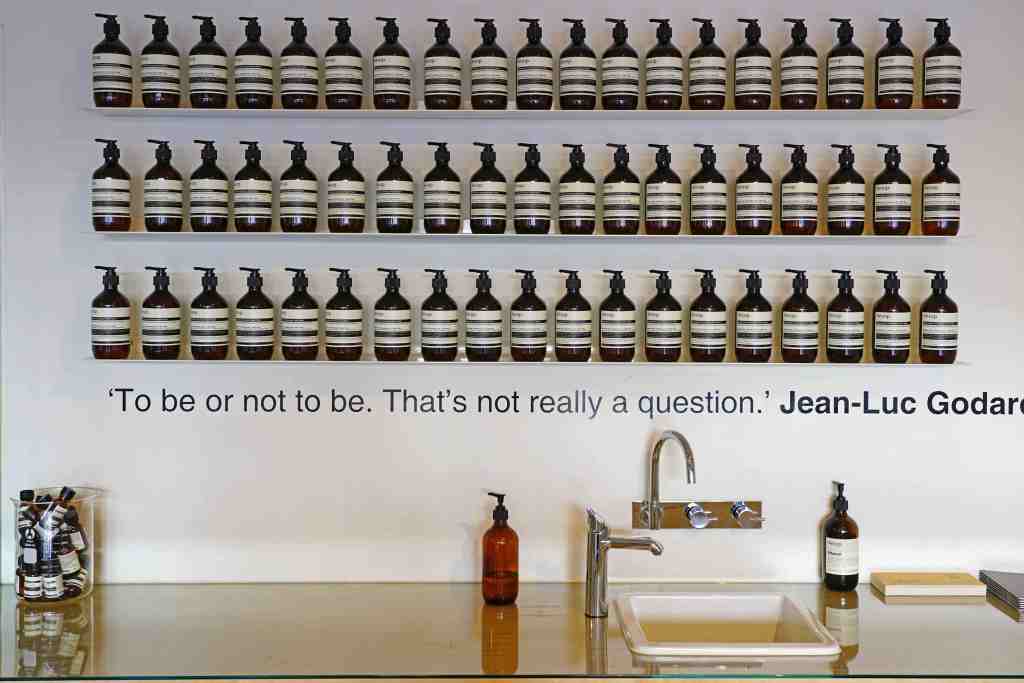
It is a charming sort of cult, built on the shoulders of its eponymous Greek fabulist. Cults need a story and the handwash has one – as earnest, intriguing and lyrical as any ancient tale. It is one of ‘essential oils’ – the likes of orange, rosemary and lavender. It is one of woody aromas, feeling ‘cleansed and refreshed’, of the benefits of the restoratively herbaceous.
So perhaps it isn’t any wonder, given the state of things, that the remedial clutches of a well-scented bathroom product has drawn us in. We, the great unwashed, must be replenished, and the gilded world of Aesop is a gateway to something more, even if ‘more’ is merely washing our hands in the toilet of a cocktail bar in Haggerston.
I do not for one moment doubt the quality of Aesop. Surely there isn’t a more emphatically made handwash. It sets the tone with a pinpoint aesthetic. But we might also be aware that, probably, we have all been a little duped. What seems like a bashful brand – it has never advertised – must be calculated, too. Because actually there is no escaping the fact that an Australian man has convinced us (and I include myself in this, absolutely) that spending £70 on a pot of hand balm is completely normal.
Britain’s best boltholes for under £50 a night
Whether it’s train fares, energy bills or the supermarket shop, prices are rising and belts are tightening. But if you’re desperate to get away from it all, it’s still possible to have a break on a budget – however many people you’re taking with you.
From cosy couples’ cabins to beach houses big enough for two families, and from Scotland to Sussex, these seven boltholes offer spring getaways with plenty of wow factor – and all cost no more than £50 per person per night.
For couples
Tahuna Bothies, Aberdeenshire
Sleeps: 2-4
Price: From £100 a night (£50 each for two people)

These wooden huts on a corner of Scottish coast are a stargazer’s dream. By day, the floor-to-ceiling windows flood them with light and views of seals lounging on Newburgh Beach (a five-minute walk away). By night, you catch wisps of the Milky Way and, if you’re lucky, the Northern Lights. The local area is a dedicated ‘dark skies’ site, so there’ll be no disruption from street lights.
A romantic option for couples, the bothies have a double bed on a mezzanine level. Each comes equipped with a kitchen, TV and board games. There is a sofa bed in the main lounge area as well, so it’s also workable for a family of four. Some welcome dogs.
The bothies are run by friendly twin sisters and sheep farmers Gail and Tanya Davidson and were designed by their architect brother. Crumbling Slains Castle – thought to have inspired Bram Stoker’s Dracula – and buzzy Aberdeen are within 20 minutes’ drive.

Scilly Stack, Cornwall
Sleeps: 2
Price: From £82 a night (£41 each for two people)
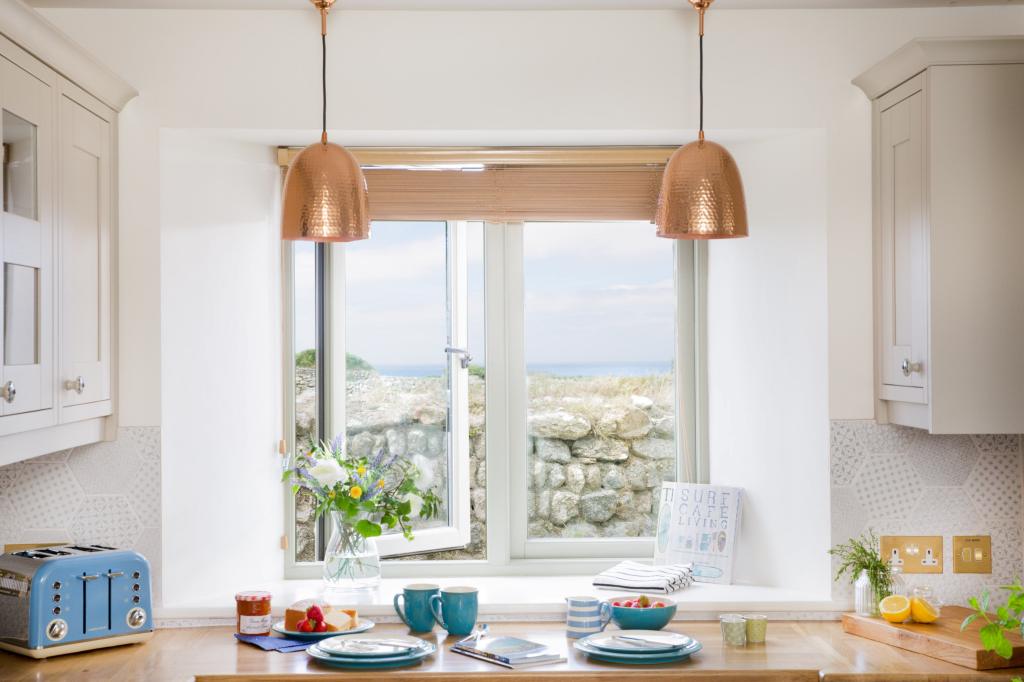
Starting life as a cow shed, this stone building has been turned into a petite but chic hideaway. Stylish furnishings and fittings, including a walk-in rain shower, have hidden any trace of its past function – but the farmyard charm remains.
The breakfast bar looks out over the sea – and you can drink in the view as you sip Cornish coffee with milk and dipped shortbread from your welcome hamper. The property is just a few hundred metres from Cape Cornwall – England’s only official cape – and a gorgeous spot for coastal hikes. Ten minutes’ walk away is Cot Valley, an underrated part of Cornwall hiding mysterious coves and beaches strewn with dinosaur egg-like boulders.

For families
Cotswold Farm Park, Gloucestershire
Sleeps: Up to 5 adults plus 1 infant
Price: From £100 per night (£20 each for 5 people)

One to delight the children, Cotswold Farm Park is home to more than 50 rare breeds of British farm animals – from glossy Suffolk Punch ponies to floppy-eared Boer goats and shaggy Highland cattle. Lambing season is a popular time to visit, when you can bottle-feed the new arrivals or see baby chicks hatch. Guests enjoy unlimited free access to the farm park during their stay.
There’s a range of accommodation to suit most group sizes. The Songbird Safari Tent is a good family option, sleeping up to five plus a baby. The safari tents have fully working kitchens with electricity, lighting and USB sockets as well as their own private bathrooms. There’s also a larger tent that sleeps seven (plus a baby) and comes with a hot tub and log-burner.
If you’re happy with a more back-to-basics approach to camping, there are pods which sleep up to four (from £15 per person per night) and have shared washrooms. Don’t forget to pack wellies.
The Matchbox, East Sussex
Sleeps: Up to 6
Price: £285 per night (£47.50 each for 6 people)

The suntrap deck of this beach house looks directly on to Rye Harbour Nature Reserve. It’s just a five-minute walk from pretty (though pebbly) Winchelsea Beach – a safe swimming spot. Sleeping up to six, the house is ideal for one big family or two small ones. Its exposed wood and whitewashed interiors ooze charm, tempting you to stay inside with the log-burner or in the rolltop bath. But go out you must, as the surroundings are equally gorgeous. Rye, with its cobbled streets and Tudor inns, is less than five minutes away by car.
Surf boards tucked under the stairs ensure hours of entertainment as the younger ones (and the adults) attempt to ride the waves. The wraparound terrace is perfect for barbecues (logs and kindling are provided to get you started) – but if you don’t fancy cooking, you’re not short of lovely spots for lunch or fish and chips locally either.

Fritton Lake, Norfolk
Sleeps: Up to 4
Price: From £160 per night, including breakfast (£40 each for 4 people)
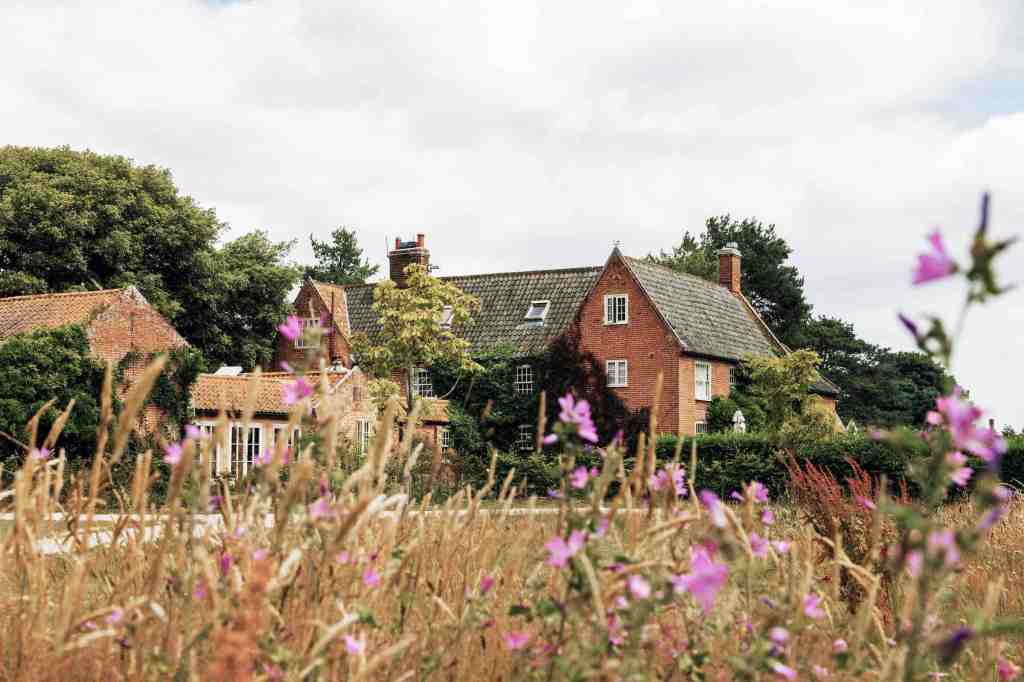
This 1,000-acre woodland with tennis courts, an outdoor heated swimming pool, running trails and adventure play is the ideal playground for adults and kids alike. While the children splash about on paddleboards and in kayaks, parents can watch from Fritton Lake’s floating sauna. The high-end holiday camp also offers experiences for the whole family, including Jeep safaris (where you spot water buffalo and giant black pigs) and foraging excursions.
Tear yourself away from the lake and within 20 minutes in one direction you can be sailing on the Norfolk Broads, while in the other you have popular beaches and coastal walks. Fritton’s Mr Kittles family room in the attic sleeps four under its slanted beam ceilings. If you want to be more self-contained, you can also rent a four-person coach house for around the same price. The latter comes with a well-equipped kitchen, Nespresso coffee maker and washing machine (for after those muddy walks).

For big groups
Seabank, West Sussex
Sleeps: Up to 8
Price: From £80 per night (£10 each for 8 people)

These two bluebell-coloured railway carriages date back to the 19th century, spending many decades trundling along the line from Brighton to London and back. After the first world war they were converted into holiday homes and now form one large property, Seabank, in the Sussex seaside town of Selsey.
The four bedrooms inside the carriages open out inside a shared hallway and there’s a light-filled kitchen with a long picture window that looks straight out on to the beach. The original painted doors and brass handles add to the feeling that you’re in a Victorian time warp. The minimum stay is two nights. As for the location, you could hardly be closer to the sea. Selsey itself is famous for its crab (try it at the Crab and Lobster gastropub). A visit to Pagham Harbour nature reserve is also worth fitting in.
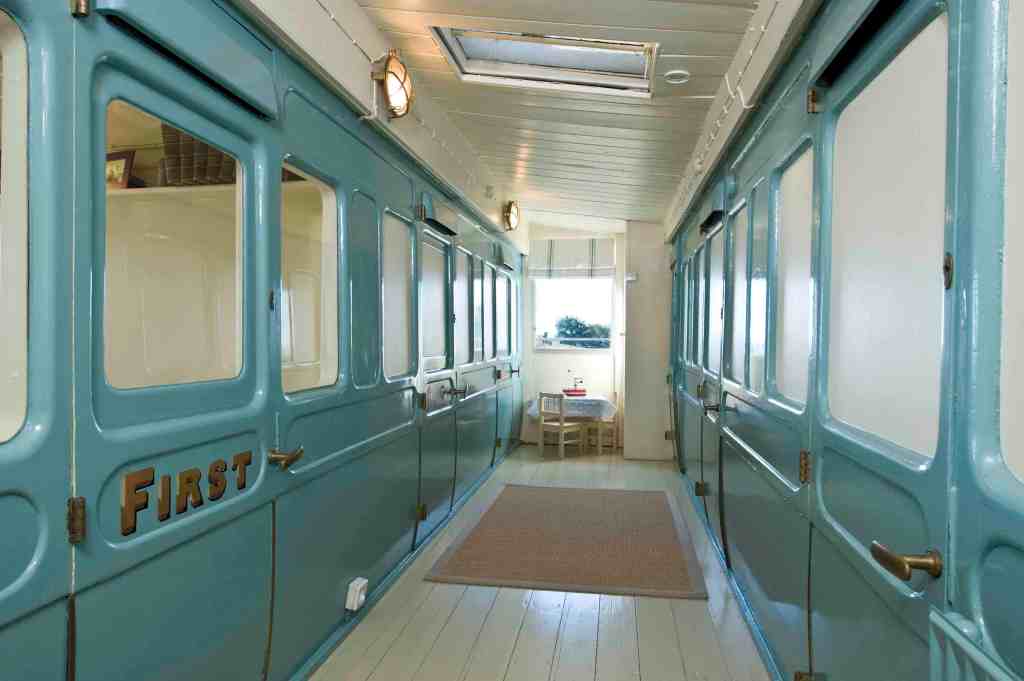
The White House, East Sussex
Sleeps: Up to 10
Price: From £432 per night (£43 each for 10 people)
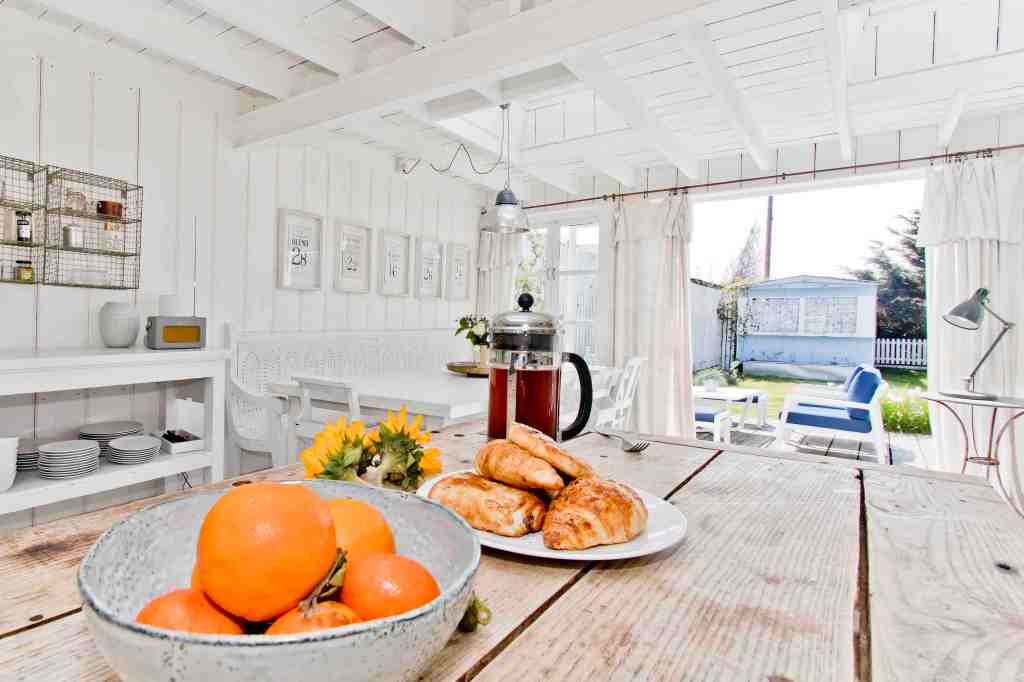
Arguably the nicest beach in Sussex, Camber Sands stretches for five miles of golden sands and grass-flecked dunes. From the veranda of The White House, an elegant bungalow, you feel like it’s your own private playground thanks to a garden gate that acts as a secret door to the beach.
The timber interiors have the shabby chic of a French farmhouse, decked out pretty much solely in whites and pale greys. The four bedrooms sleep ten comfortably and there’s a homely sitting area with a log burner. In the south-facing garden a hammock hangs between two apple trees. Kids can play table tennis while grown-ups work the charcoal barbecue. Dogs are welcome.
For shops and pubs, Rye is a ten minute drive away. Camber also provides an ideal base from which to set out on wine-tasting excursions at Sussex’s vineyards – fast becoming famous for their top-quality bubbly.

Ghost story: the dark side of Rolls-Royce
Some years ago, I was despatched to Las Vegas to learn how to be a chauffeur. The Wynn hotel had purchased a fleet of Rolls-Royces, and their Aloysius Parkers were being taught how to drive the Rolls-Royce way – i.e. a cut above your Lincoln Town Car etiquette. ‘The umbrella can be used both defensively and offensively,’ I recall Rolls-Royce’s Andi McCann saying, as if he’d walked off the set of Kingsman. Andi is the personal driver to Rolls’s CEO Torsten Müller-Ötvös and the company’s lead trainer. I learned many things on his white-glove course, starting with how umbrellas, housed inside each door, can be used to protect from paparazzi and marauders; why the car must always be parked with its rear to the kerb (the other way would be disrespectful to the ornamental winged lady); and why you always place luggage in the boot before opening the suicide doors for the client (peace of mind that their valuables are safe). The ‘principal’ client sits behind the passenger seat, diagonally across from the driver. Once on board, you make eye contact with them in the rear-view mirror to check they’re at ease, and then you flip the mirror for their privacy. At this point came an obvious question: what is the protocol if the client is hoovering rails of cocaine off the custom marquetry? ‘Try not to spill any,’ came Andi’s reply.
Which brings us to the Black Badge Ghost, a Rolls-Royce which is more likely to be driven by the owner than the regular (or ‘silver’) Ghost, but where there’s definitely a party going on inside. A Black Badge car sees the grille and Spirit of Ecstasy sprayed black. It has huge, brawny carbon-fibre rims. It eschews mahogany for modern materials and is liable to be painted or upholstered in popping colours that are more Miami (turquoise and orange) than Royal Mews (claret and cream). Even behind the wheel it feels edgier, due to its slightly firmer ride, more urgent throttle and discernible growl. It’s designed for a younger demographic: filthy rich under-forties who identify as disruptors.

A decade ago, if you’d visited the home of a Rolls-Royce owner and asked the way to the loo, they’d have told you ‘down the hall, past the Monet and left at the Picasso’, recalling the floorplan of Jeffrey Archer’s penthouse. But now, at least as far as the Black Badge gang goes, it’s more likely that the owner’s art collection comes in the form of NFTs. They reject suits for streetwear and use blockchain rather than banks.
Why are NFTs changing hands for hundreds of thousands – sometimes tens of millions – of pounds? Don’t ask me; at least with the Black Badge Ghost you can see where the money’s gone. This is a glorious thing, inside and out. How much does it cost? Rolls-Royce won’t even tell you – not until it’s been fully spec’d up anyway. There is no starting price. That’s how bespoke it is.
Black Badging extends not only to the four-door Ghost, but the Wraith coupé, Dawn convertible and Cullinan SUV too, and was triggered by a trip Mr Müller-Ötvös took to Los Angeles. He emerged from Beverly Hills’s SLS Hotel one evening to find a chap pulling up in a Phantom Drophead which had been independently pimped and ‘murdered-out’. Introducing himself, Müller-Ötvös said to the driver: ‘I like it, but why have you done this?’ The man – a plastic surgeon – told him he’d wanted a car that gave him an alter-ego.

The meeting inspired a more assertive direction for product styling. TMÖ had to lobby Rolls’s owner BMW, which after considerable resistance finally backed down and allowed the Spirit of Ecstasy to go dark – both literally and metaphorically. Black Badge now represents nearly 30 per cent of all Rolls-Royce sales, and takes inspiration from the fact their customers all carry a black Amex Centurion card. Black means luxurious, exclusive, mysterious and minted.
How much does it cost? Rolls-Royce won’t even tell you – not until it’s been fully spec’d up anyway. There is no starting price. That’s how bespoke it is
Buyers can define their own custom hue, or select from 44,000 (that’s not a typo) prét-à-porter colours. Most simply opt for the signature black. Just as catholic priests (in Father Ted’s telling, anyway) wear the blackest socks, Rolls boasts the industry’s darkest black. The paint weighs 45kg alone. The whole car, unladen with Kardashians and Krug, is a whisker under 2.5 tonnes.
Like Michael Howard, there’s something of the night about this car. With darkness as the theme and with it due to descend en route, I’m handed the keys to an all-black example and tasked with driving from Rolls’s Mayfair showroom to Hove on the East Sussex coast for an on-brand dinner. I think the theory is that Hove is the edgiest place one can reach two hours from W1 without risking those 21in rims getting pinched. The name ‘Hove’ immediately makes me think of Jay-Z – and if you don’t get that rap reference then I’m afraid you don’t qualify to become a Black Badge member.

Having wrestled south through the rush-hour traffic, the road clears after Purley and the flying lady tears through the foggy dusk (over 40mph, at last!), the car’s shadow stretched like that of an Ikko Narahara photo as we approach the M23. The Ghost’s twin-turbocharged 6.75-litre V12 is sufficient in anyone’s book, but this one generates an extra 28bhp – a total output of 591 thoroughbreds. When it comes to performance, the engineers had an interesting challenge; to create a driving personality that matches the Black Badge’s visual intent without compromising that famed magic carpet ride. The Ghost’s all-aluminium spaceframe architecture is superb starting point, both stiff in body and flexible in adaptability. This car has four-wheel-steer as well as all-wheel-drive. It also boasts the genius Rolls-patented Planar suspension system which irons out the dips and bumps. These systems, all on the regular Ghost, have been reengineered for Black Badge, including fitting more voluminous air springs to alleviate body roll under more assertive cornering. Between that and the satellite-aided transmission, this limousine takes roundabouts like a Lotus.
These roundabouts pave the way to Etch, a fine dining restaurant by Masterchef: The Professionals winner Steven Edwards, who took the show’s spoils ten years ago at the age of 26. Set on Hove’s Church Road in what was once a bank, there are 12 tables and one choice – the tasting menu. But I and my fellow Rolls-Royce arrivistes (as in, this is how we each arrived) are ensconced in the private dining room downstairs, adjacent to Edwards’s cellar bar Ink, which was previously a tattoo parlour. The walls are black, with dark and moody artworks of skulls by Magnus Gjoen, a former designer for Vivienne Westwood, and flashes of neon by street artist Ben Slow. The food and cocktail menus both promise to ‘breathe new life into classics’, which seems to sum up what Black Badge is about. And like the Marmite-infused bread we’re served, maybe a murdered-out Rolls isn’t for everyone (although I hate Marmite, and this brioche was bloody delicious).

After our seven-course indulgence, a chauffeur appears to whisk the Sunday Times’s John Arlidge and me back to London. The rear of a Black Badge Ghost is a most cosseting place to sit and savour the warm buzz from the wine pairing and stare up at the Starlight Headliner – hundreds of skilfully-woven fibreoptic LEDs representing the night sky, including shooting stars. Kitsch, maybe, but atmospheric (and a five-figure accessory, FYI). The dash has aluminium fibres rendered in carbon, known as Technical Weave. The sense of noir is heightened by subduing all the brightwork. There are seatback TVs, and crystal flutes included in the fizz fridge behind the arm rest – but no bottle in ours, so we are denied a nightcap on the way home.
The ambience treads a very fine line between red carpet glitz and luxuriant substance. Rolls’s aesthetes have, I’m told, turned to haute couture for inspiration, in particular the work of Kei Ninomiya, Rick Owens, Yohji Yamamoto and John Varvatos. In terms of peers, Rolls has also compared its work to pioneering sailing yachts Maltese Falcon, Black Pearl and Philippe Starck’s Sailing Yacht A.
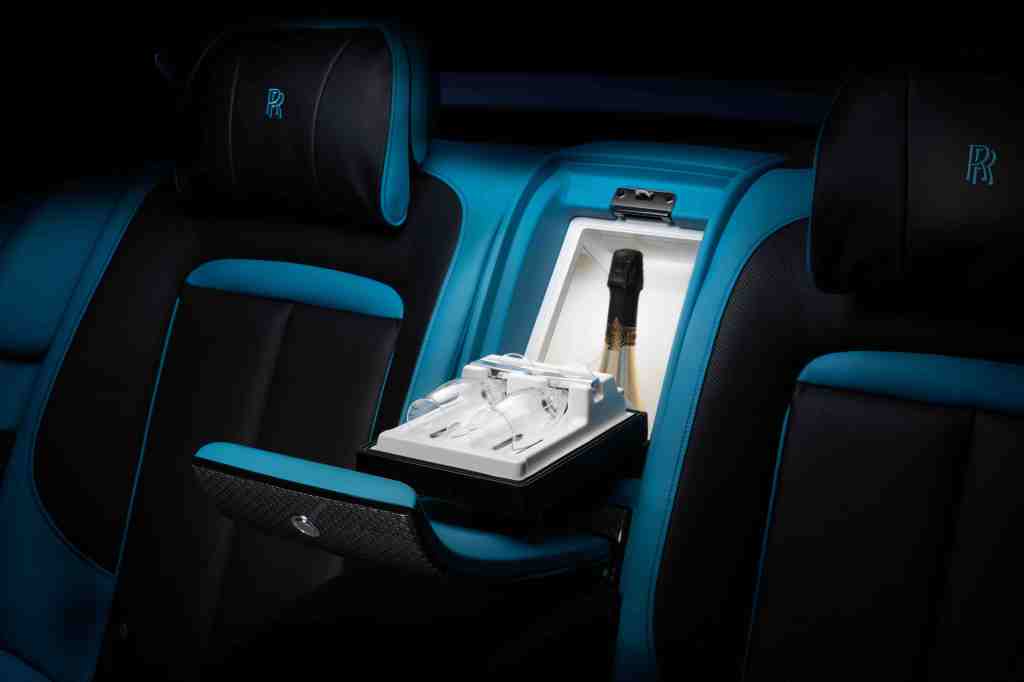
When the Black Badge range started to appear six years ago, a lot of traditionalists were up in arms that Rolls-Royce was diverting from polished chrome and lacquered walnut. But the bulk of Rolls’s global audience is nouveau riche and always has been. A lot of the criticism of bold hues, aggressive wheels and sparkly lights has undercurrents of ageism and racism.
From its very earliest days, Rolls-Royce has attracted creative minds, free spirits and iconoclasts – John Lennon, Elvis and Elton among them. It’s worth considering that the company’s founders, Charles Rolls and Henry Royce, were the disruptors of their day. Had they been born a century later, maybe they could pass for Silicon Valley bros. Their backgrounds couldn’t have been more different (engineer Royce came from nothing, while aristo Rolls wore white tie spattered with oil, earning him the nickname ‘Dirty Rolls’), but they were both mightily ambitious and bonded over their love of technology and desire to shake things up. These guys were the Elon Musk and Peter Thiel of yesteryear, and with the Black Badge Ghost their visionary and subversive ways are being celebrated today.

SNP ‘power couple’ face dissent from within
There’s more trouble in Scotland’s nationalist paradise. A storm is brewing amongst members of the SNP’s innermost ruling group as it is revealed that party secrets have been kept from its very own National Executive Committee. The resignation of the party’s auditors, details on finances and the exodus of party members all came as much as a surprise to the party’s ruling group as they had to the rest of the nation.
But it doesn’t stop there. Fresh allegations have sprung from a source deep within the party: an NEC whistleblower described how a group of senior figures including ‘power couple’ Sturgeon and Murrell demanded that the NEC be ‘disbanded’ in order to launch an inquiry meant to save the party from electoral disaster. The anonymous source didn’t hold back, saying that the party has become ‘rotten to the core’.
And now, a member of the SNP’s NEC has threatened to quit if the party does not hire forensic auditors to assess its finances. The threat, which comes from Bill Ramsay, the convenor of the SNP Trade Union Group, comes amid an escalating row over the SNP’s lack of transparency, and an ongoing police investigation into the party’s funds.
Ramsay said:
In June last year, I was making calls for more transparency. Indeed, I forced a vote to ensure that members of the NEC could see how other members were voting. My call for a full-day NEC meeting to address the way the party is run is still being resisted, it seems. This, and talk of a review, is not taking the need for urgent change nearly seriously enough. If the call to appoint forensic auditors is not moved forward, I will have to seriously consider whether I can continue on in the NEC.
This follows the arrest of former chief executive Peter Murrell last week, a police raid both of former first minister Nicola Sturgeon’s own home – and a day-long search of SNP HQ. A campervan worth £110,000 – allegedly bought for ‘campaigning’ purposes during the pandemic – has also been seized from outside Murrell’s mother’s house in Dunfermline. First Minister Humza Yousaf was forced to admit earlier today that even he had not been informed about the motorhome until, er, after he had been elected as SNP leader.
And so the Sturgeon-Murrell saga continues…
Mary Quant 1930–2023
The fashion designer and icon Mary Quant has died at the age of 93. Brigid Keenan wrote the following piece in 2019.
It is almost impossible to explain to today’s readers why Mary Quant (and the other Young Designers, as they became known) had such a huge impact. Over the half-century since, there have been so many ‘new’ ideas in fashion that her and their initial shock value has been diluted. Luckily, though, the Christian Dior exhibition is also showing at the V&A, and a quick visit there — look particularly at the fashions of the 1950s — will give you a clue.
Pre-Quant, clothes were constricted: fussy, fitted, buttoned, cuffed, boned. They demanded a lot of the wearer. Mary’s were unstructured and she took her inspiration from surprising places.
Her grey flannel suit that I fell in love with — which my friend who worked in the Quant sewing room replicated for half the price — had a casual jacket, cut like a man’s blazer and a box-pleated skirt. Box pleats were more often used for school skirts in those days (Mary liked adapting school uniform; the pinafore was another favourite). As well as using jersey fabric, which was unusual, she made a feature of zip fasteners rather than hiding them away. She also put men’s braces on skirts and trousers, and she made vests fashionable. And she used PVC for raincoats (shock horror: plastic in fashion!). She didn’t altogether invent the short skirt; the couturier Courrèges did that (I saw it with my own eyes). But she took it to mini heights. She invented hotpants and she launched tights (these had been invented in the US, but Mary produced them in black, yellow, red, shocking pink, green, etc.)
Mary also created the kind of make-up girls were desperate for. We all wanted Beatnik black eyes and, even more, almost-white lipstick, but before Mary you had to find someone going to Paris to buy it for you. She had her own hair cut into a bob by Vidal Sassoon, and inspired a generation to copy her.
Mary and I were not bosom friends (she is painfully shy), but I was often at their office in Ives Street, Chelsea, chatting with her husband Alexander Plunket Greene, or watching their exciting fashion shows (totally different from any others at the time, with loud music, energetic models, contemporary make-up) or choosing clothes to feature.
Time passed and I left the paper. After trying (and failing) to be a famous war reporter in Vietnam, I went back to my true home on the Sunday Times, as fashion editor once again. Mary Quant was about to turn 40. The Queen of Youth, the epicentre of the youthquake, was entering middle age. I phoned Mary to arrange an interview, but she wouldn’t agree. I wrote to her. I sent a bouquet of flowers. But she was adamant: she would not talk about being 40. I thought of something else to write about, but I was hurt and at the back of my mind I held it against her. (Which didn’t stop me from putting her forward for a damehood a few years ago — supported by David Bailey and Terence Conran. It was a serious oversight that she hadn’t received one decades before.)
It’s never too late for life to surprise you. In the course of making the video at the V&A for its Quant exhibition, I discovered why Mary had been so obstinate in her refusal all those years ago. She hadn’t been 40 at all, but 45; she’d lied about her age because she was older than her husband and in those days we kept these things secret. Mary, I am sorry – all is forgiven.
Watch: Humza flails on motorhome seizure
Even the most skilled politician would struggle with the legacy left by Nicola Sturgeon – and Humza Yousaf is very far from being skilled. The new First Minister has been forced to do an awkward interview today, outlining what he knew about the recent raid on his predecessor’s home. Yousaf has now admitted that a luxury motorhome seized by police during an investigation into SNP finances is owned by the party. He also confirmed that he had seen the warrant listing other items confiscated as part of the probe, saying:
Of course the police have done the responsible thing in terms of giving us, and I as leader have seen the warrant, in terms of the items that they’ve confiscated, including the motorhome that you referenced.
Probed on when he became aware of the motorhome being an SNP asset, the First Minister would only reply: ‘Shorty after I became the leader of the party’. How soon was that? With questions continuing to mount over the party’s finances, there is a race against the clock now to find new auditors for the SNP’s financial accounts after its previous firm quit last September. That news only came out, er, last week, just six months after Johnston Carmichael walked away from the brief.
Tick Tock Humza…
Gove’s war on buy-to-lets will kill the holiday economy
The term ‘hostile environment’ was dreamt up by the Home Office to describe a policy of making migrants lives’ so difficult that they would be minded to pack up and leave the country. But it could equally well have been coined to apply to the government’s policies towards buy-to-let investors.
For years, governments of all colours sat back and did nothing as rampant house price inflation priced many young people out of the market. Then something clicked and George Osborne, together with his successors at No. 11, decided that it was not a good idea to have investors and speculators scoop up properties by the armful, outbidding aspirant owner-occupiers.
Without places to stay, people are not going to travel 200 miles to spend money in tourist attractions, restaurants and shops
But rather than do something positive like tackle delays in the planning system, or reducing regulation and levies on house-builders, ministers trained their eyes on investors, with a mind to make their lives a misery through fiscal and regulatory hell.
Since then we have had an extra 3 per cent stamp duty, so that buyers of second properties worth more than £250,000 pay a marginal rate of 8 per cent. We have had the rules changed to stop landlords setting their full interest repayments against tax; we have had landlords warned that they will be banned from letting out properties from 2028 unless they have an Energy Performance Certificate rating of at least ‘C’ – with huge fines for disobeying.
Now, Michael Gove wants to force property owners to seek planning permission before using their homes as holiday lets. This will mean having to incur application fees of hundreds of pounds even if permission is granted.
People need homes to live in, but they also want places to go on holiday. Holiday lets may annoy some local residents, but they are also the economic lifeblood of many popular areas. Without places to stay, people are not going to travel 200 miles to spend money in tourist attractions, restaurants and shops.
True, if a town or village becomes dominated by holiday lets and second homes, pricing out permanent residents, it can damage the community. Yet Gove’s initiative will do nothing to prevent the latter phenomenon: properties bought up by the wealthy to be used for their personal occupation a few weekends of the year and left empty the rest of the time. Second homes left unoccupied for long periods damage the social structure of a town or village while bringing minimal benefit to the local economy (save for people who sell and maintain alarm systems).
Indeed, all Gove will succeed in doing is to switch some holiday lets to pure second homes as their owners decide it is too much bother to seek planning permission. Depending on whether an exemption is granted for occasional holiday lets through Airbnb and the like (such a rule has been mooted), it could also harm the many local people who earn a little money on the side by letting out their homes while they themselves go off on holiday.
This occasional holiday letting makes for a tremendously efficient use of property. It allows the availability of holiday lets to increase during the holiday season, making use of homes which would otherwise be empty. But of course it doesn’t suit the big guys of the holiday-letting trade: the caravan and holiday park owners who would really like the market all to themselves. A requirement to seek planning permission will cause little problem for them: if their properties are purpose-built, they will already have such permission.
Depressingly, this is how so much legislation comes to exist: it is sewn up between ministers and lobbyists acting for big business who want fussy rules to make life hell for their smaller competitors. We voted to leave the EU in the hope of easing unnecessary regulations on business. Sadly, the government has taken on the task of generating punishing new regulations of its own.
